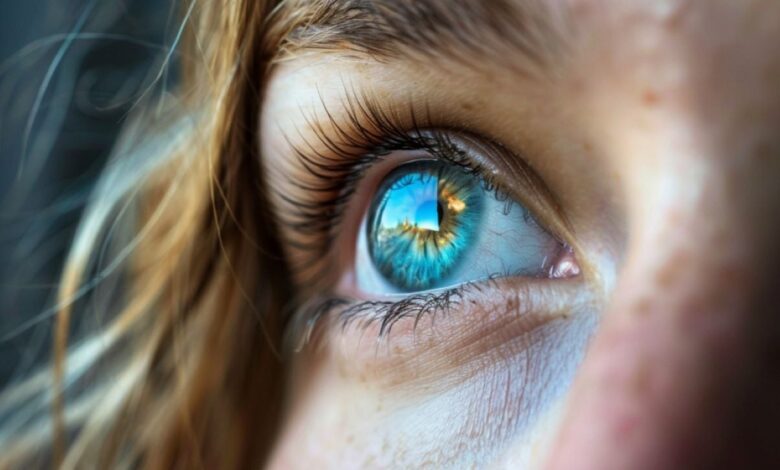How Our Brain Deciphers Gaze Direction

[ad_1]
Summary: A new study reveals the precise moment the brain detects gaze direction, enhancing our understanding of social interactions and disorders like autism and Alzheimer’s. Researchers used EEG and machine learning to analyze brain activity when participants viewed avatars with varying head and eye directions.
They found the brain first processes head orientation before eye direction, with task context influencing gaze perception accuracy. This breakthrough could aid early diagnosis and treatment of autism and Alzheimer’s.
Key Facts:
- Hierarchical Processing: Brain first detects head orientation at 20ms, then eye direction at 140ms.
- Task Influence: Accuracy in detecting gaze direction improves when attention is focused on the gaze.
- Diagnostic Potential: Findings may aid early diagnosis and treatment for autism and Alzheimer’s.
Source: University of Geneva
The gaze plays a central role in everyday social interactions. Our capacity for instant communication relies on the brain’s ability to detect and interpret the direction of others’ gaze. How does our brain detect gaze direction, and what factors influence the process?
In a recent study published in the journal NeuroImage, a team from the University of Geneva (UNIGE) succeeded in determining with unprecedented precision the exact moment at which the direction of gaze is detected.

These findings significantly enhance our understanding of autism spectrum disorders and could offer therapeutic prospects for people affected by Alzheimer’s disease.
Human faces are the most common and consistent visual stimuli that we encounter from the second we are born. Our brain has developed the expertise to memorize and recognize faces, as well as to interpret messages they convey. For instance, the direct eye gaze signals a desire to engage in social interaction, while avoiding eye contact conveys the opposite message. But how rapidly can our brain comprehend the gaze of others?
This topic has been extensively researched. However, existing publications predominantly focus on studying the eye region in isolation, neglecting other factors like head orientation.
Cerebral analysis of gaze
A team from UNIGE presented to study participants the 3D avatars, each featuring different head and gaze directions. In the first task, volunteers were asked to indicate the orientation of the head, while in the second task, they had to identify the direction of the eyes.
By analysing the brain activity using an electroencephalogram, the research team has discovered that these two processes can be reliably decoded independently of each other.
‘‘The experiment also demonstrates a certain hierarchy in the processing of these two information. The brain first perceives the more global visual cues, i.e. the orientation of the head, from 20 milliseconds onwards, before focusing on the more local information, i.e. the eyes, from 140 milliseconds onwards.
“This hierarchical organisation then allows for integration of eye region and head orientation information, to ensure the accurate and effective judgement of gaze direction,’’ explains Domilė Tautvydaitė, a postdoctoral fellow and associate researcher at the UNIGE, Faculty of Psychology and Educational Sciences, and the study’s first author.
The study also demonstrates that the decoding of gaze direction was significantly more accurate when participants were specifically asked to pay attention to the gaze of the presented faces. This means that the task context influences the perception and understanding of the gaze.
‘‘In everyday life, these results show that when people are actively engaged in a ‘social mode’, they are better and faster at recognizing the intentions of other people,’’ explains Nicolas Burra, senior lecturer at the Faculty of Psychology and Educational Sciences and director of the Experimental Social Cognition Laboratory (ESClab) at UNIGE, who led this research.
A cutting-edge method
The method used provides extremely accurate results for these two mechanisms. By integrating the analysis of neural activity using electroencephalography (EEG) with machine-learning techniques, the research team could predict the decoding of gaze and head direction even before the participants were aware of it.
‘‘This method represents a significant technical innovation in the field, allowing for a much more precise analysis than it was previously attainable,’’ adds Nicolas Burra.
In people with autism spectrum disorders, the decoding of this information may be impaired, and the avoidance of eye contact may be preferred. This is also the case for Alzheimer’s disease, where during disease’s evolution, memory difficulties impoverish the person’s relationships with others and often lead to social withdrawal. It is therefore essential to understand the neural mechanisms in detecting the gaze direction.
The study results and the method used make a concrete contribution to the early diagnosis of autism spectrum disorders in children. Concerning Alzheimer’s disease, one of the most striking symptoms as the disease progresses is the inability to recognise faces, even those of family members.
This study therefore paves the way for a better understanding of the neural mechanisms linked to reduced social interaction and memory for faces- a subject currently being studied by Dr Tautvydaitė at McGill University in Canada. The UNIGE’s ESClab laboratory research will continue in this field by analysing these processes during real-life social interactions.
About this visual neuroscience research news
Author: Antoine Guenot
Source: University of Geneva
Contact: Antoine Guenot – University of Geneva
Image: The image is credited to Neuroscience News
Original Research: Open access.
“The Timing of Gaze Direction Perception: ERP Decoding and Task Modulation” by Nicolas Burra et al. NeuroImage
Abstract
The Timing of Gaze Direction Perception: ERP Decoding and Task Modulation
Distinguishing the direction of another person’s eye gaze is extremely important in everyday social interaction, as it provides critical information about people’s attention and, therefore, intentions.
The temporal dynamics of gaze processing have been investigated using event-related potentials (ERPs) recorded with electroencephalography (EEG).
However, the moment at which our brain distinguishes the gaze direction (GD), irrespectively of other facial cues, remains unclear. To solve this question, the present study aimed to investigate the time course of gaze direction processing, using an ERP decoding approach, based on the combination of a support vector machine and error-correcting output codes.
We recorded EEG in young healthy subjects, 32 of them performing GD detection and 34 conducting face orientation tasks. Both tasks presented 3D realistic faces with five different head and gaze orientations each: 30°, 15° to the left or right, and 0°.
While the classical ERP analyses did not show clear GD effects, ERP decoding analyses revealed that discrimination of GD, irrespective of head orientation, started at 140 ms in the GD task and at 120 ms in the face orientation task. GD decoding accuracy was higher in the GD task than in the face orientation task and was the highest for the direct gaze in both tasks.
These findings suggest that the decoding of brain patterns is modified by task relevance, which changes the latency and the accuracy of GD decoding.
[ad_2]
Source link




